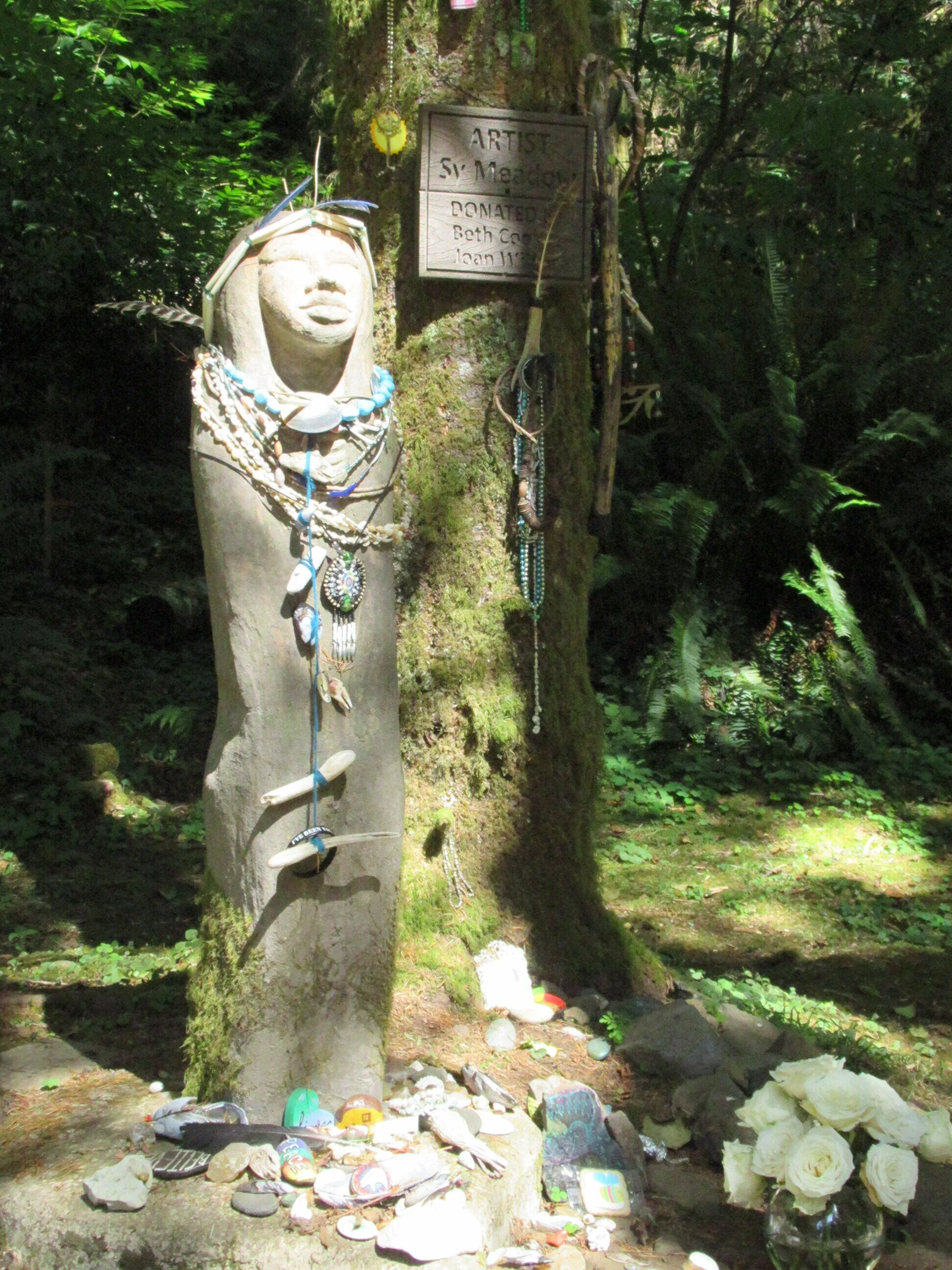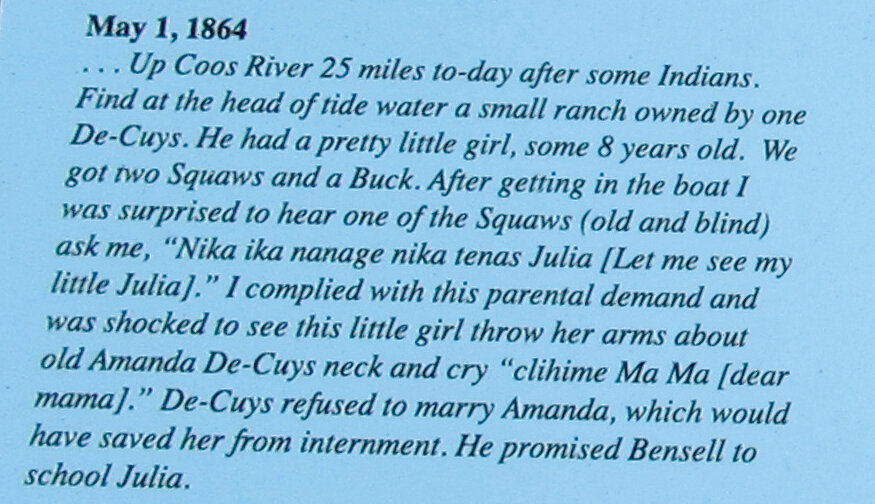Dave’s Detours: Amanda’s Trail
By Dave Powell
For the TODAY
This is a detour into time and history rather than spaces along the Oregon Coast Trail (OCT). I hope this diversion increases your wonder at what is constantly around us.
I have for years volunteered in Yachats, helping the trails and invasive plants crews. I also am with Trailkeepers of Oregon. A major TKO idea is “preserve current trails, with the idea that we’re not willing to lose another trail to neglect.” Each work party always mentions this land wasn’t always ours. Considering the increasing numbers of hikers I have seen as people escape pandemic cabin fever, please consider finding, helping, and funding organizations maintaining, re-opening and creating trails.
It is 1864
The civil war is continuing with attrition diminishing the South and leading to the re-election of Abraham Lincoln in the fall.
Colorado’s territorial governor, John Evans, in August 1864 commanded Coloradans to “kill and destroy … hostile Indians.” In November, the volunteer Third Colorado Cavalry perpetrated the Sand Creek Massacre, killing around 230 Cheyenne and Arapaho people, mostly women, children and the elderly. Evans’ order was not formally revoked until August this year.
In May, Amanda De Cuys, a blind Coos woman, is force-marched 80 miles up the Oregon Coast to the Alsea Sub-agency of the Coast Indian Reservation at Yachats. Amanda is removed from her common-law husband and daughter when he refused to marry her. Over the sharp rocks at Cape Perpetua her feet are cut so badly she left a bloody trail. Reaching the Alsea Sub-agency camp, there is no further note of her but it is thought she was among at least 300 Indians who died at the military camp.
A very short history of Yachats.
In 1875, congress opens area to settlers. The Alsea Sub-agency is closed.
In 1917, the village of Oceanview decides the name is too common, and it is changed to Yachats.
A longer history of the Amanda Trail
In 1984 Loyd Collett, director of Cape Perpetua Scenic Area, responsible for several trails at Cape Perpetua, attends a seminar by Dr. Stephen Beckham on Native American history and decides to name trail on north side of Cape Perpetua after Amanda. The trail was not built for safety reasons — Siuslaw National Forest (SNF) property ends at Highway 101 in a dangerous manner.
In 1986 Joanne and Norman Kittel purchase 27 acres north of the Siuslaw National Forest, although they live in Minnesota.
In 1990 they met with the Oregon Parks and Recreation Department to set rough trail path through their property connecting to Cape Perpetua.
In 1993 they move to Oregon and the complex process of creating Amanda Trail begins.
In 1996 Joanne Kittel and Suzanne Curtis co-author, “Early Yachats history: The Yachats Indians, origins of the Yachats Name and the Prison Camp Years” under supervision of tribal members Robert Kentta and Don Whereat plus Phyllis Steeves, SNF archaeologist and Tribal liaison.
An extract from the journal of Corporal Royal Bensell, who was part of a detachment tasked with rounding up Native Americans who had fled the Coast Reservation.
In 1997 the Amanda Trail was built by Angell Job Corps in the Siuslaw National Forest, covering a distance of 2.1 miles, with half a mile on the Kittels’ property easement built by volunteers. On Labor Day weekend the original bridge is built by SNF staff, Angell Job Corps, the Kittels and friends in three days. In April 1998 the trail is dedicated with 120 people attending, including several tribal members. Yachats had previously been shunned by Tribal members because of its Sub-agency history.
You would think that ends the story, but everything always takes longer (think home improvement rule of thumb, i.e. twice as long, twice as expensive). It would take another 12 years to make the final connection to the City of Yachats.
Joanne Kittel witnessed a dangerous passing situation on Highway 101, with a vehicle forcing a woman to dive into a ditch full of blackberry to avoid being hit.
In 2008/9 Jerry and Kathleen Sand work with Joanne Kittel to present the Oregon Department of Transportation the idea of connecting the OCT to E. Windy Way, cross Highway 101, and extend the trail to Yachats Ocean Road. The City of Yachats wrote a grant application, provided matching funds although most of the project was outside the city limits and created the Yachats Trails Committee. With contractor help Yachats Trails volunteers built the new section of trail, finishing a critical safety gap in the Oregon Coast Trail. The Amanda Trail was finally completed, and it only took 25 years. A second dedication is held with almost 200 guests, including more than 30 Tribal members.
In 2011 the original bridge needed replacement. After several months of preparation, the second bridge is built in four days by state parks staff, Angell Job Corps students, Tribal members, Yachats locals and others.
And now to my time on the Oregon Coast.
In early December 2015, I move out to the Oregon Coast and start to learn of the Oregon Coast Trail. I plan to start hiking OCT New Year’s Day at Yachats. On December 19, a clear-cut dating from 2003 produced a mudslide estimated between 45 and 50 million tons traveling at about 30 to 40 miles an hour, obliterating the Amanda Creek, new Amanda Bridge and the Amanda Statue, stopping at Highway 101.
In 2016 the New Year’s Day hike to the Grotto is cancelled, and rerouted to the Ya’Xaik Trail. Four months later (mid-April) the area is determined to be safe, so rebuilding work began. Over the course of six weeks, 78 people worked to re-open Amanda trail, and use part of the damaged bridge as a temporary bridge. Thanks to the efforts of volunteers including state parks and federal forest service personnel, Yachats Trails volunteers, the Urban Forestry Program of the Angell Job Corps, the Confederated Tribes of Siletz Indians, the Confederated Tribes of Coos, Lower Umpqua and Siuslaw Indians, County Corrections Crew, the trail was re-opened by Memorial Day weekend. Three Amanda statues were created in 1999. The purchase of a replacement was unnecessary as Beth Cook and Joan Wikler donated one to the trail, so Amanda now stands in the new gathering area again.
To the present day
It is August 26, 2021, and I am in Yachats at the Cape Perpetua Volunteer Appreciation dinner. It was a chance to hear news of other organizations.
During the gathering a question was asked, “How far do you travel to volunteer at Yachats?” The largest group, which includes myself, travel more than 20 miles.
Different organizations shared news, finishing with Joan Kittel’s talk on the new Amanda suspension bridge. She shared the amazing news that the project begins October 1 and that, because of a COVID-related extension, grants which would normally have expired were still committed by their organizations. And the higher cost was being covered by Oregon State Parks.
Of course, you are welcome to come to Yachats and join in trail work or donating to projects supporting the Oregon Coast Trail. I will continue to be there often.
Note: This article is only a short summation of Amanda’s Trail. More information can be found at View The Future site at the “2022 Bridge Dedication” tab and the “View the Past” tab.
OCT news update:
The suspension bridge at Cape Perpetua for Amanda’s Trail starts construction on October 1.
The section south of the Amanda Statue will be closed from October 1, possibly until February 28, 2022. No trail detour is available.
The trail on the north side of the Amanda statue will have intermittent closures during this same period. When that occurs, notices will be sent out via City of Yachats, the trails committee, visitor center, chamber and local Facebook pages.


